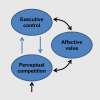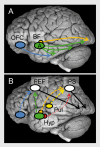Emergent processes in cognitive-emotional interactions
- PMID: 21319489
- PMCID: PMC3117594
- DOI: 10.31887/DCNS.2010.12.4/lpessoa
Emergent processes in cognitive-emotional interactions
Abstract
Emotion and cognition have been viewed as largely separate entities in the brain. Within this framework, significant progress has been made in understanding specific aspects of behavior. Research in the past two decades, however, has started to paint a different picture of brain organization, one in which network interactions are key to understanding complex behaviors. From both basic and clinical perspectives, the characterization of cognitive-emotional interactions constitutes a fundamental issue in the investigation of the mind and brain. This review will highlight the interactive and integrative potential that exists in the brain to bring together the cognitive and emotional domains. First, anatomical evidence will be provided, focusing on structures such as hypothalamus, basal forebrain, amygdala, cingulate cortex, orbitofrontal cortex, and insula. Data on functional interactions will then be discussed, followed by a discussion of a dual competition framework, which describes cognitive-emotional interactions in terms of perceptual and cognitive competition mechanisms.
La emoción y la cognición se han considerado como entidades ampliamente separadas en el cerebro. Dentro de este sistema, se ha realizado un progreso significativo en la comprensión de aspectos específicos de la conducta. Sin embargo, la investigación en las últimas dos décadas ha comenzado a bosquejar un cuadro diferente de la organización cerebral, entre las cuales las interacciones en redes son clave para comprender las conductas complejas. Tanto desde la perspectiva básica como clínica, la caracterización de las interacciones cognitivo-emocionales constituye un tema fundamental en la investigación de la mente y el cerebro. Esta revisión destacará el potencial interactivo e integrador que existe en el cerebro para reunir los aspectos cognitivos y emocionales. Primero se entregará la evidencia anatómica, focalizada en estructuras como el hipotálamo, el cerebro anterior basal, la amígdala, la corteza cingulada, la corteza órbito-frontal y la ínsula. Luego se discutirán datos acerca de las interacciones funcionales, seguidos del análisis de un sistema dual competitivo que describe las interacciones cognitivo-emocionales en términos de mecanismos de competencia perceptivos y cognitivos.
L'émotion et la cognition ont été considérées comme des entités complètement séparées dans le cerveau. Dans ce contexte, la compréhension des aspects spécifiques du comportement a fait des progrès significatifs. Cependant, la recherche de ces 20 dernières années a commencé à décrire un autre tableau de l'organisation cérébrale, dans laquelle les interactions du réseau sont la clé de la compréhension des comportements complexes. Que les perspectives soient fondamentales ou cliniques, la description des interactions cognitivo-comportementales constitue une question centrale de la recherche sur la pensée et le cerveau. Cet article soulignera le potentiel interactif et intégratif du cerveau afin de réconcilier les domaines cognitif et émotionnel. Nous fournirons d'abord des arguments anatomiques, en insistant sur les structures comme l'hypothalamus, le prosencéphale, l'amygdale, le cortex cingulaire, le cortex orbitofrontal et l'insula. Nous analyserons ensuite les données des interactions fonctionnelles, puis nous étudierons le double cadre compétitif, qui décrit les interactions cognitivo-émotionnelles en termes de mécanismes rivaux de perception et de cognition.
Figures





Similar articles
-
Dynamic Networks in the Emotional Brain.Neuroscientist. 2017 Aug;23(4):383-396. doi: 10.1177/1073858416671936. Epub 2016 Oct 25. Neuroscientist. 2017. PMID: 27784761 Free PMC article. Review.
-
Précis on The Cognitive-Emotional Brain.Behav Brain Sci. 2015;38:e71. doi: 10.1017/S0140525X14000120. Epub 2014 Jun 10. Behav Brain Sci. 2015. PMID: 24914882 Review.
-
The emotional brain: combining insights from patients and basic science.Neurocase. 2009 Jun;15(3):173-81. doi: 10.1080/13554790902796787. Neurocase. 2009. PMID: 20183547 Free PMC article.
-
On the relationship between emotion and cognition.Nat Rev Neurosci. 2008 Feb;9(2):148-58. doi: 10.1038/nrn2317. Nat Rev Neurosci. 2008. PMID: 18209732 Review.
-
A domain-general brain network underlying emotional and cognitive interference processing: evidence from coordinate-based and functional connectivity meta-analyses.Brain Struct Funct. 2018 Nov;223(8):3813-3840. doi: 10.1007/s00429-018-1727-9. Epub 2018 Aug 6. Brain Struct Funct. 2018. PMID: 30083997 Free PMC article.
Cited by
-
Affective attention under cognitive load: reduced emotional biases but emergent anxiety-related costs to inhibitory control.Front Hum Neurosci. 2013 May 13;7:188. doi: 10.3389/fnhum.2013.00188. eCollection 2013. Front Hum Neurosci. 2013. PMID: 23717273 Free PMC article.
-
A biased activation theory of the cognitive and attentional modulation of emotion.Front Hum Neurosci. 2013 Mar 18;7:74. doi: 10.3389/fnhum.2013.00074. eCollection 2013. Front Hum Neurosci. 2013. PMID: 23508210 Free PMC article.
-
Interactions between affective and cognitive processing systems in problematic gamblers: a functional connectivity study.PLoS One. 2012;7(11):e49923. doi: 10.1371/journal.pone.0049923. Epub 2012 Nov 28. PLoS One. 2012. PMID: 23209619 Free PMC article.
-
Alexithymia Predicts Carotid Atherosclerosis, Vascular Events, and All-Cause Mortality in Human Immunodeficiency Virus-Infected Patients: An Italian Multisite Prospective Cohort Study.Open Forum Infect Dis. 2019 Jul 27;6(9):ofz331. doi: 10.1093/ofid/ofz331. eCollection 2019 Sep. Open Forum Infect Dis. 2019. PMID: 31660407 Free PMC article.
-
Musical experience prior to traumatic exposure as a resilience factor: a conceptual analysis.Front Psychol. 2023 Jul 27;14:1220489. doi: 10.3389/fpsyg.2023.1220489. eCollection 2023. Front Psychol. 2023. PMID: 37599747 Free PMC article. Review.
References
-
- Risold PY., Thompson RH., Swanson LW. The structural organization of connections between hypothalamus and cerebral cortex. Brain Res Brain Res Rev. 1997;24:197–254. - PubMed
-
- Swanson LW. Cerebral hemisphere regulation of motivated behavior. Brain Res. 2000;886:113–164. - PubMed
-
- Rempel-Clower NL., Barbas H. Topographic organization of connections between the hypothalamus and prefrontal cortex in the rhesus monkey. J Comp Neurol. 1998;398:393–419. - PubMed
-
- Mesulam M-M. Behavioral neuroanatomy: Large-scale networks, association cortex, frontal syndromes, the limbic system, and hemispheric specializations. In: Mesulam M, ed. Principles of Behavioral and Cognitive Neurology. New York, NY: Oxford University Press;; 2000:1–120.
-
- Mesulam MM., Hersh LB., Mash DC., Geula C. Differential cholinergic innervation within functional subdivisions of the human cerebral cortex: a choline acetyltransferase study. J Comp Neurol. 1992;318:316–328. - PubMed
Publication types
MeSH terms
Grants and funding
LinkOut - more resources
Full Text Sources
Miscellaneous
